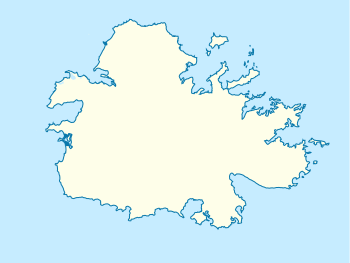English Harbour
| English Harbour | |
|---|---|
| Village | |
|
English Harbour and Falmouth Harbour | |
 English Harbour | |
| Coordinates: 17°00′N 61°46′W / 17.000°N 61.767°WCoordinates: 17°00′N 61°46′W / 17.000°N 61.767°W | |
| Country | Antigua and Barbuda |
| Island | Antigua |
| Population (2012) | |
| • Total | 620 |
| Time zone | AST (UTC-4) |
English Harbour is a natural harbour and settlement on the island of Antigua, in the extreme south of the island. The settlement takes its name from the nearby harbour in which the Royal Navy established its base of operations for the area during the eighteenth century. Its population is 759 (2001 Census).
English Harbour is a centre of boating, especially yachting. There are two sheltered deepwater harbours nearby; English Harbour itself and Falmouth Harbour.
Naval history

English Harbour is best known for Nelson's Dockyard, a former British Navy base; it displays restored 18th and 19th-century buildings and other historical artifacts from the colonial period of the dockyard, especially the time it was commanded by Horatio Nelson.
.jpg)
The Royal Navy had begun using English Harbour as a safe haven in the 17th century. In 1704 Fort Berkeley was built on a spit across the harbour entrance to defend it.
HM Naval Yard, Antigua, began on the eastern side of the harbour (on the site presently occupied by the Antigua Slipways boatyard) in the 1730s. The Yard was expanded across the bay on the western side (on the site known today as Nelson's Dockyard) in the 1740s. Both sites remained in use over the following decades. Each at first consisted of careening wharves and storehouses; to these, other buildings were added over time. By the end of the Napoleonic Wars a substantial complex of facilities had been developed at English Harbour: in addition to the twin Dockyards, the Harbour accommodated a Victualling Yard, an Ordnance Yard (where the Gunpowder House Hotel now stands) and a Royal Naval Hospital. The Commissioner (the senior Navy Board official at the Dockyard) resided at Clarence House on a hillside overlooking the bay.[1]
After 1815 the dockyard decreased in importance. By the 1850s the eastern yard was being used as a coal store and the western yard was described as being in poor repair.[1] Nevertheless the yards remained open, finally closing in 1889. Sixty years later, the first moves were made toward preserving what became known as Nelson's Dockyard. Today it flourishes as a yachting centre as well as a historic monument,[2] and is described as 'the only working Georgian dockyard in the world'.[3] Much of the surrounding area is a National Park.[4]
References
- 1 2 Coad, Jonathan (2013). Support for the Fleet: architecture and engineering of the Royal Navy's bases, 1700-1914. Swindon: English Heritage.
- ↑ "UNESCO listing application".
- ↑ "Tourist information".
- ↑ "nationalparksantigua.com".
